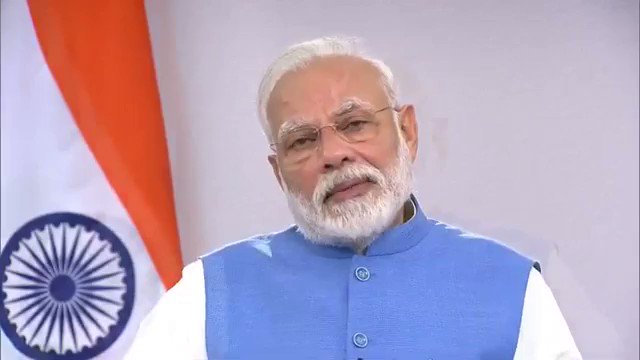New Delhi, March 22
An unprecedented shutdown commenced across the country on Sunday morning on Prime Minister Narendra Modi’s appeal for a ‘Janata curfew’ to help check the spread of coronavirus.
As the ‘Janata curfew’ got underway at 7 am, people largely kept themselves indoor as part of the social distancing exercise to stop the spread of the virus and bare number of public transport vehicles plied on nearly empty roads.
All markets and establishments except those dealing in essential goods and services will be closed for the day.
The ‘Janata Curfew’ will end at 9 pm.
Ahead of the start of the curfew, Prime Minister Narendra Modi said, “In a few minutes from now, the #JantaCurfew commences. Let us all be a part of this curfew, which will add tremendous strength to the fight against COVID-19 menace”.
In a few minutes from now, the #JantaCurfew commences.Let us all be a part of this curfew, which will add tremendous strength to the fight against COVID-19 menace. The steps we take now will help in the times to come.
Stay indoors and stay healthy. #IndiaFightsCorona
He said the steps to be taken now will help in the times to come.
“Stay indoors and stay healthy,” he said on Twitter.
In the national capital, the roads were deserted with barely some private vehicles and buses plying. Vendors were off the roads in the morning hours with people confining themselves to their homes.
In Mumbai, the usually bustling western and eastern express highways and other arterial roads looked empty as people stayed in their homes to support the curfew.
Same was the situation at the suburban train stations which normally see thousands of commuters jostling to get inside the overcrowded trains.
Cutting across party lines, chief ministers and others leaders have urged the people to follow the self-imposed curfew, noting that “social distancing” was key to breaking the chain of transmission, as the number of coronavirus cases rose to 283 after 60 new cases were detected on Saturday, the highest so far in a day.
States like Maharashtra, Odisha, Rajasthan, and Bihar have announced either complete or partial lockdown till the month-end.
No passenger train will originate from any railway station in the country from midnight to 10 pm on Sunday while all suburban train services will be reduced to a bare minimum as well. Metro services, including in Delhi, Hyderabad, and Mumbai, will remain suspended for the day.
Air carriers like GoAir, IndiGo and Vistara have announced that they will be curtailing domestic operations on Sunday.
Traders’ body Confederation of All India Traders (CAIT) has announced that they will keep their establishments shut across the country for the ‘Janata curfew’.
From suspending regular prayers involving large gatherings in shrines of various faiths, including Sunday mass, to disallowing jail inmates from meeting their families on the day, organisations and institutions in every sphere have announced restrictions.
Modi had on Thursday called for the ‘Janata curfew’ from 7 am to 9 pm on March 22, saying no citizen, barring those in essential services, should get out of their houses, and asserted that it will be a litmus test to show India’s readiness to take on the coronavirus challenge.
Union Home Secretary Ajay Bhalla has asked chief secretaries of all states to ensure that the ‘Janata Curfew’ is observed properly and to see that local bodies, fire services, police and civil defence blow sirens or ring bells on Sunday evening to express gratitude towards those involved in tackling the disease.
“We are looking for unity in isolation,” Joint Secretary in the Ministry of Health Lav Agarwal had said.
Describing it as the need of the hour, Union Home Minister Amit Shah had asked everyone in the country to support the step.
Vice President M Venkaiah Naidu had also made a fervent appeal to the people of the country to confine themselves to homes. He said that since the virus spreads through physical contact, social distancing is an effective measure to contain its spread by avoiding contact during the incubation period of the virus.
“It is a matter of great assurance that people have responded very positively to Prime Minister Narendra Modi’s appeal,” Union Minister Ravi Shankar Prasad said on Saturday.
In Delhi, Chief Minister Arvind Kejriwal had said that 50 percent of the buses will ply on roads on Sunday considering some people may have to travel due to an emergency.
Autos and taxis will, however, be off roads in the national capital as several unions including the Delhi Autorickshaw Sangh, Delhi Pradesh Taxi Union, Delhi Auto Taxi Transport Congress Union and Delhi Taxi Tourist Transport Association, have decided to join the ‘Janata curfew’.
Uttar Pradesh Chief Minister Yogi Adityanath had also appealed to the people of the state to stay indoors on Sunday.
“Metro trains, roadways buses and city buses will not operate on Sunday,” the statement said on behalf of the chief minister.
“To curb this infection, we are working on a war footing. Isolation wards have been set up in every district hospital and medical college. So far, 23 patients have been identified in the state, out of which nine have completely recovered. There is no need to panic, but prepare yourself to fight against this challenge,” the UP chief minister had said in the statement.
Leaders and other prominent personalities also urged the traders not to hoard essential items and the people to purchase only necessary things. — PTI





















































































































